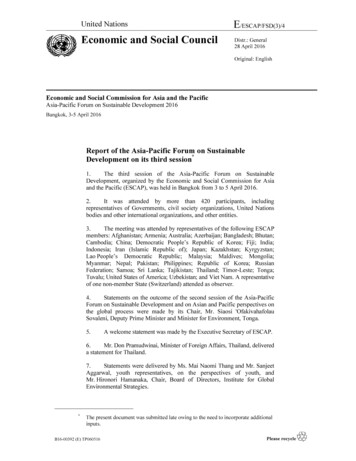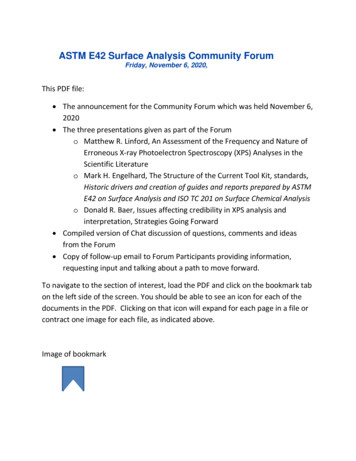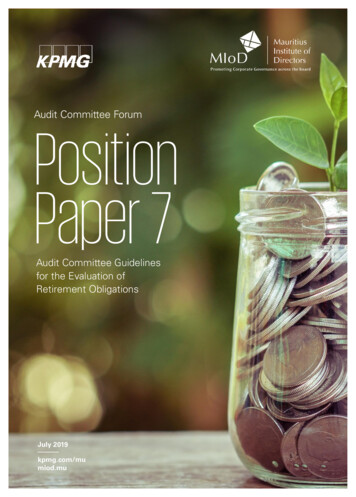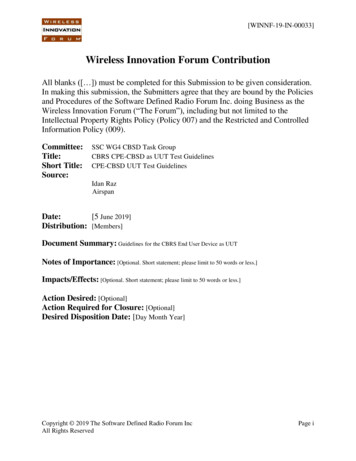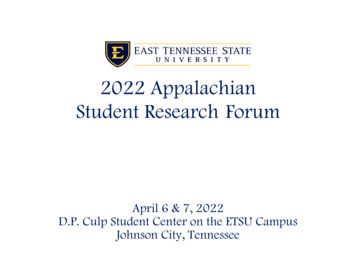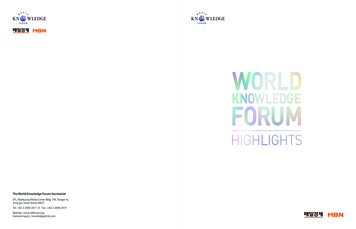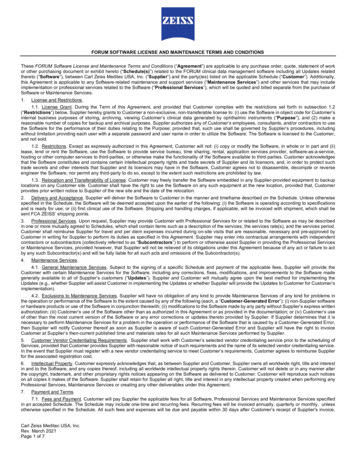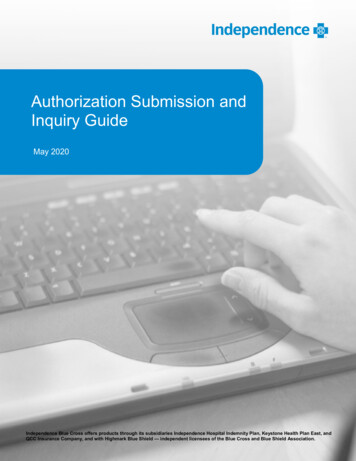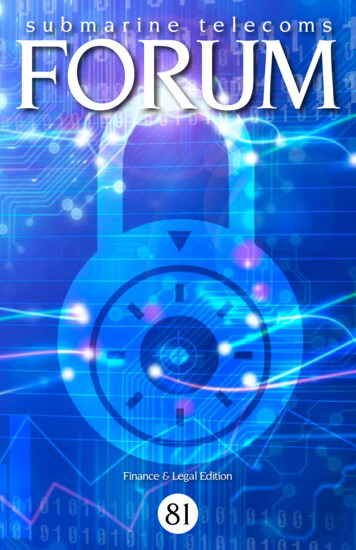
Transcription
Finance & Legal Edition81
WEBSITE TRAFFIC - UNIQUE VISITS59,65610-1459,5019-1455,6458-1450,44852,137T O TA L H I T S I N 2 0 1 5 ,97259,08532,165387.340Issue #78 - Released 9-14Issue #12 - Released 11-14Issue #13 - Released 2-1549,71649,71649,716D O W N L OA D S T O D AT EIssue #79 - Released 11-14Issue #80 - Released 1-15Issue #11 - Released 8-14
Welcome to Issue 81, ourFinance and Legal Edition.After a fairly brutal winterhere on the East Coast, wehave just started to feel theearly promises of spring; somewould say, and none too late.Three years ago, after anotherparticularly brutal winter, Ibought a big snow blower,and since that time I haveused it only few times – untilthis year, which made up forall the other easy seasons. Iactually enjoy running thatbig machine up and downmy drive, and even help theneighbor across the road whenI’m just getting warmed-up.I recently invited my wife totry it out on a 10 inch cover,but she simply said “No” andleft the dog and me to oursnowy fun.It’s the same for my generator,which I bought the year wewent for 45 hours powerlessin the middle of one reallytough winter. I haven’t usedthe generator yet this year, butone day not too distant away Iwill and be glad that my waterpump and such are running.I’m not saying it was so,so rough. I spent15 years afterall teachingboyandgirl scoutsa b o u thandlingdicey situations;I’m justsayingthatit’seasier witha snow blower and genera-tor some winters than without.I call them my insurance policy.Kind of like the variousauthor experts we have inthis issue. In simple words,these are the kind of guys youwant to have available whenthe business climate is toughand the lights are blinkinguncontrollably. They providesome excellent perspective ofthis multi-faceted topic andnone too soon!Happy reading.Wayne Nielsen is the Founder and Publisher ofSubmarine Telecoms Forum, and previously in1991, founded and published “Soundings”, aprint magazine developed for then BT Marine.In 1998, he founded and published for SAICthe magazine, “Real Time”, the industry’s firstelectronic magazine. He has written a numberof industry papers and articles over the years,and is the author of two published novels,Semblance of Balance (2002, 2014) and SnakeDancer’s Song (2004). 1.703.444.2527wnielsen@subtelforum.com
In This Issue.4ExordiumWayne Nielsen81016Advertiser Index28Paid Prioritizations: The FCC & Net NeutralityGeorge M. Foote36Flury Of Cybersecurity Initiatives May Impact OperatorsRoss Buntrock50Summary: The FCC’s Net Neutrality RulesWesley Wright62Financing a New Private Submarine Cable NetworkAndrew D. Lipman, Ulises R. Pin& Adam SharpNews NowFinance & Legal: An OverviewKieran Clark74Understanding The FCC’s New International ReportingRequirements For Submarine Cable Operators, CapacityHolders, And CarriersKent Bressie & Danielle Piñeres90Back ReflectionStewart Ash96Advertiser’s CornerKristian Nielsen100CodaKevin G. Summers
Advertiser IndexOFSwww.ofsoptics.com24Terabit Consultingwww.terabitconsulting.com48WFN Strategieswww.wfnstrategies.com88
NewsNow AAG Submarine Cable’s LatestRecovery Effort To Be CompletedBy 6 March Almanac Issue 13 Is Available Now Byron Clatterbuck Now Takes OverAs CEO At Seacom E-marine Plans Fleet Expansion Fastweb, MENA Sign Deal ToConnect Cable System To Europe Feasibility Study On NewSubmarine Fibre Optic CableLaunched C & C Technologies To Be Acquired Fiber Optic Cable Proposed For Caribbean IXP To Build Data Center Gambia Opens Network Centre ForBy Oceaneering InternationalHosting Facility In Trinidad &Tobago China Approves New CrossingPacific Cable Project Ciena to Further Upgrade JapanU.S. Cable Network Damaged Submarine Cable SlowsDown Internet To The US Don’t Blame Sharks For AsianInternet ProblemsUpper Lynn CanalACE cable Glitch In Submarine Cable SlowsBangladesh Internet Speed GlobeNet Announces The OpeningOf New Brazil Office Government Of Equatorial GuineaAwards Huawei Marine ContractTo Build Ceiba-2 Submarine CableSystem Guinea-Bissau NegotiatesSubmarine Cable Access
NewsNow Huawei And Huawei Marine ShowIndustry Leading Super 100G AndSubsea Solution On IIR WDMAfrica 2015 Industry Supplement Issue 1 Internet Back To Full Speed Internet In Vietnam Back To 100%Normal As Cable Cut Welded:Report Level 3 Files For Extension WithFCC UPDATED Level 3 Files For SAC ExtensionWith FCC Nigeria’s Investments In SubmarineCables Hit 2.24b Nitel To Work With Lagos GovtOver SAT-3 Cable Restoration OFS Launches New OpticalCoherence Tomography (OCT)Probe Capability At BiOS /Photonics West Conferences Pacnet First to Extend SDN & NFVCapabilities Into the Optical Layer Pakistan To Get SEA-ME-WE-5Submarine Cable Landing ThroughTWA Samoa Fiber Optic Deal In ThePipeline Natixis Announces Closing OfSeabras-1 Financing New Player Building East CoastData Center For Trans-AtlanticConnectivity Seaborn Secures Metro NetworkAnd Fiber Backhaul In Brazil FromNetell And Citatel Submarine Cables in the SargassoSea Nigeria: Council Plans To IncreaseSubmarine Cable Landing Stations
NewsNow SubOptic 2016 Emerging Subsea Vocus Communications To Expand Tele-Post Greenland Expects Sea West Africa Cable System to Be Telstra Hits 100G On Key Asia-Pac West Lake Macquarie Without Tenerife Island Council Upgrades WFN Strategies Receives 2015 TM Inks MoU With Time dotCom WFN Strategies to AccomplishNetworks – The World’s expandingtreasureCable Extension In 2016Submarine CablesMetro Fiber-optic NetworkFor New 3,500km Submarine Cable Trans Pacific Express Selects Cienafor Submarine Cable Upgrade Trans-Tasman Cable GetsRegulatory Green Light UCL Researchers Double The ErrorFree Transmission Distance ForSubsea Optical Cables Undersea Cable Faults ReportedlyAffect Internet Connectivity AcrossIndiaCapacity On Southern Cross CableNetworkUpgradedPhone, Internet For Three WeeksVirginia Excellence AwardPermitting and EnvironmentalMonitoring for BLAST SubmarineCable
Finance & LegalAn OverviewKieran Clark
WelcometoSubTelForum’s annual Financeand Legal issue. This month,we will take a look at theindustry’s current finance andlegal status by presenting ourmost current data as trackedby the ever evolving SubTelForumdatabase,whereproducts like the Almanac,Cable Map, and the STFSupplement find their roots.It has been a full year sinceour last look at the financialsituation of planned systemsaround the world.Newsystems have been announcedandannouncedsystemshave gone into service, whileothers have been delayedor changed. Quite a lot canhappen in one year, and thisyear was no different.Since our last Finance andLegal issue, we observedthat of the planned systemsannounced to be ready forservice in 2014, only 38 percentwere actually accomplished.This is a far-cry from 2013,where we saw 83 percent ofsystems go from planningto reality.Several of theremaining systems were eitherdelayed to 2015 for variousreasons, while 38 percentof the systems scheduled tobe ready for service in 2014simply died outright. Whilethis is perhaps concerning,we have seen an additional12 systems announced to beready for service from 2015 to2017 compared to last year’snumbers.Aswecontinueourcomparison to last year’snumbers, we can also observea slight shift in the type ofsystem ownership. Last year,we saw an even split betweensingleownershipandconsortium ownership. Thisyear, we can see a significantshift to single owner systems.Over the next three years, only37 percent of systems willbe owned by a consortium,with the remaining 63 percenthaving a single owner. ThisPLANNED SYSTEMS ANNOUNCED RFS2520151050201520162017
Planned Systems 2015-2017By Region2%Atlantic24%CaribbeanIndian Ocean4%54%8%6%2%is an interesting developmentconsideringthecurrentuncertainty in the industryat large and especiallyconsidering the rather dismalplanned-to-implementedratio observed in 2014.MediterraneanMiddle EastPacificPolarConsortiumownershipreduces the financial risk toany single owner should acable system fail, so seeingPlanned Systems CIF2015-201717%CIFNot CIF83%that trend decrease in thecurrent market might seemcounterintuitive. However,if we look a little deeper,we can see that many of thenew systems over the nextseveral years are relativelysmaller systems, serving veryspecific needs. Many of thesystems planned for 20152017 are connecting variousisland nations in the Pacifictoexistinginternationalpipelines or are like the onesplanned in the South Atlantic,connecting to only a fewlanding points. Keeping thisshift in ownership in mind,this model makes more sense.While single owners are backon the rise, the way a systemis being financed has changedlittle from last year, althoughthere has been a small change.One year ago, we observedthat 43 percent of systemswere financed through debt/equity and 57 percent wereentirely self-financed. Thisyear, we’ve seen a shiftthat brings the two types offinancing dead even witheach other. This is not a largeshift, but it does indicate thatsystem owners and financiersare increasingly less willing
to take on the increased riskof debt/equity financing andare starting to prefer havingcash more or less guaranteedup front.When you consider thenature of many of the systemsplanned for the next fewyears, these numbers makesense. With so many of theplanned systems addressingvery specific needs in smallerareas, there is not much ofa business case to justifyfinancing based on the higherrisk associated with debt/equity financing.Compared to last year, therehas been very little changein the breakdown of plannedsystems by region. The Pacificand South Atlantic continueto see numerous systemsplanned and make up themajority of total plannedsystems. While still slight,the Middle East and IndianOcean regions have seen thelargest decrease in activityfrom a year ago, presumablydue to political and financialinstability in those regions.The factors driving growthin the Pacific and SouthAtlanticalsoremainunchanged from a year ago –Ownership Type for Planned System161412108642020152016Consortiumemerging markets clamoringfor access to affordableand reliable internationaltelecommunications.2017Single OwnerWith more than 40 systemsplanned to be ready forservice over the next severalyears, it may seem likethe industry is robust andbooming. However, thingsstart to look a little moretroublesome when you lookat whether or not a systemhas gone Contract in ForceFinancing for Planned Systems2015-201750%50%Self-FinanceDebt/Equity Finance
(CIF). This is the true measureof a system’s viability and isusually a strong indicator thata system will be completed.Last year at this time, we sawonly 7 percent of the systemsplanned for 2014-2017 becomeCIF. One year later, thingshave only slightly improved,with 17 percent of announcedsystemsfrom2015-2017Kieran Clark is an Analystfor Submarine TelecomsForum.He joined thecompany in 2013 as aBroadcast Technician toprovide support for liveevent video streaming. In2014, Kieran was promotedto Analyst and is currentlyresponsible for the researchandmaintenancethatsupports the SubTel ForumInternationalSubmarineCable Database; his analysisis featured in almost theentire array of SubTelForum publications. He has4 years of live productionexperience and has workedalongside some of thepremier organizations invideo web streaming.achieving the CIF milestone.Looking at 2015 alone, 29percent of systems plannedto be ready for service thisyear have gone CIF so far.However, with nearly threemonths of 2015 passed, thisseems like a low CIF rate.Considering that many ofthe systems scheduled to beready for service this yearhave yet to complete a survey,we can expect several systemsplanned for implementationthis year to at least be delayed.daunting at the best of timesand when there is uncertaintyit can look even worse. Thesedays, a system must have arock-solid business case toconvince investors to providethe needed capital. It is adifficult path for new systems,but 2015 promises to be a littleeasier on the financing side.Financing continues to be amajor hurdle for new systemsand is a trend that will likelynever go away. The investmentrequired for an internationalsubmarine cable can feelFrom shore to shore . . .OFS’ fiber solution enables 100 Gb/s with high signal power & low loss performanceCoherent TransportHigh Signal PowerTeraWave and Allwave FLEX ZWP Ocean Fibers Outstanding Bend PerformanceSimplified Network DesignLong-term ReliabilityA Furukawa CompanyTo learn more, ask your cabler about OFS or visit www.ofsoptics.com/ofsoptics/ofs telecom/company/ofs/OFSoptics
2015 Rel ease Ti m el i neSubmarineCable Map6th EditionIssue 14Issue 4Issue GlobalOutlookSTFFinance& pplementSupplementSupplemenSupplementIssue 1SuppliersIssue 2SurveyorsIssue 3InstallersIssue 4Finance, Legal& PermittingIssue 5Maintenance& RepairIssue 6CableDevelopers2016Issue 13Issue 15Submarine TelecomsIndustry Calendar14th Edition
Paid PrioritizationsThe FCC & Net NeutralityGeorge M. Foote
On February 26th, theFederal CommunicationsCommission (FCC) adoptedits controversial net neutralityorder. The FCC declared thatblocking and throttling ofinternet signals is illegal and itbanned “paid prioritization”that would allow one contentprovider to pay for fasterservice than its competitors.Noting that more than halfof all internet connectionsare now made from wirelessdevices, the FCC order extendsthe new net neutrality rules towireless internet coverage.The FCC also sthat extend net neutralityprinciples to the edge of theInternet Service Provider(ISP) networks, the point atwhich ISPs connect to othernetworks, content providersand content delivery services.The interconnection rules arenot yet published, but willbe important to operators ofsubmarine cables and theircustomers.This is the third net neutralitytry for the FCC. Both previousattempts to adopt regulationshave been thrown out by thecourts.The net neutrality debate inAmerica has been fierce, withproponents of FCC actionclaiming that the internet isa public utility and deservesFCC protection. Opponentshave proclaimed that any newrules amount to governmenttakeover of the internet. Thebattle lines split regulationminded Democrats from smallgovernmentRepublicans;internet content companiesfavoring regulation squaredoff against the telecom andcable companies that plan tosue to overturn the rules. Theparties, however, are in closeragreement than most willacknowledge.Everyone appears to supportthe basic principles of anopen internet.Nobodydefends blocking or throttlingof signals or fast lanes forcompanies willing to pay. lation to make that point.Even Comcast, the ISP mostmaligned in net neutralitydebates,pledgesalmostdaily in full page ads that itwill abide by net neutralityprinciples.Few examplesof abuse of net neutralityprinciples have been shown.So is net neutrality regulationa solution to a problem thatdoes not exist?“Yes,” argue anti-regulationpolicymakersandISPs.They point to the growthof the unregulated internetin America and the swirlof innovation around theinternet as evidence thatthe system does not needgovernmentinvolvement.They claim that regulationwill stifle investment in theinternet, lead to more taxesand even price controls by thegovernment.
“No,” say consumer groupsand content providers. Theycite the lack of competition forhigh speed broadband servicein most of the country and thepotential for future controlover content or speed by theISPs. They point out that thelevel of proposed regulationis light and that the rules aresimilar to rules in effect forwireless telephones duringa period when 300 billionhas been invested in wirelessnetworks.While the FCC rules are notyet public, their outline is clear.Under the CommunicationsAct of 1934, the FCC hasauthoritytoregulatetelecommunications services inthe United States. Title II of thelaw was written in the days ofthe old Bell System monopolyand treated the phone systemlike the utility that it was. TitleII was a way for the governmentto control the monopoly. Itgives the FCC power to awardlicenses, set rates, impose fees,force companies to share theirequipment with competitors,file reports, respond tocustomer complaints andprovide service to remote areas.Is net neutralityregulation a solutionto a problem thatdoes not exist?In 1996, Congress recognizedthat Ma Bell was not the onlytelecom competitor and thatthe FCC could manage thetelecom system with a lighterregulatory regime. Congressadded “forbearance rights”to the Communications Act.The FCC now has the right toscale the degree of regulationof a service to the need. Itdoes not have to exercise allthe heavy-handed regulatorypowers in every case. In otherwords, it can choose what itwill regulate and how.From public comments andinformationreleasedbythe FCC, it is clear that FCCchairman, Tom Wheeler relieson forbearance. He intendsto impose light regulationand to depend on complaintproceedings to enforce therules -- setting out boundariesand putting a referee on thefield, as Wheeler says. TheFCC order will not createnew taxes, give rate settingauthority to the FCC, requirefiling of tariffs or compelnetwork unbundling.The Wheeler approach isinformed by FCC losses incourt in the earlier attemptsto adopt net neutralityprinciples. In striking downthe last FCC regulations, theD.C. Circuit Court of Appealstold the FCC that it had thepower to regulate the internetunder the CommunicationsAct, but that the FCC hadgone about it the wrong way.Acceptingthecourt’sinvitation and following thecourt’s roadmap, the FCChas now proposed to treat theinternet as a utility but leaveindustry participants free tocompete, set rates withoutgovernment participation andmanage networks in much thesame way as they do today.Republican leaders want anew law to limit the abilityof the FCC to police netneutrality.However, theyhave not announced plansfor how to enforce netneutrality if the FCC cannot.No congressional action cankeep up with the needs of anindustry that moves as fast astelecommunications. At theend of the day, the FCC is theonly agency that can overseethe internet.Three issues show how hardit would be for Congress tolegislate responses to netneutrality questions.First, while everyone agreesthat there should be no paidprioritization that wouldallow wealthy incumbentcontent providers to payfor better service than theirsmaller competitors, consider“zero rating.” In zero rating,
a content provider, sayAmazon, pays an ISP for thebits transmitted to Amazoncustomers.Streaming anAmazon movie would notcount against the customer’smonthlyallotmentofmegabytes of data.ThepaymentswouldmakeAmazon more attractive thanits competitors who did notsubsidize users. Neither theFCC nor Congress has shownhow they would treat zerorating.Second, wireless telephonecompanies have much morecomplex systems than wiredcompanies. Wireless trafficis managed closely, systemwide, to allocate spectrumin ways that will improveservice for customers, withthe inevitable effect thatsome calls are prioritizedover others or are routeddifferently.At what point does networkmanagement of ent? And at what pointshould the FCC step-in todictate different managementpractices? Should one formof content be favored overanother? The Title II complaintmechanisms appear to be aready answer for at least someof the questions, allowing acompany or consumer thatbelieves its service is beingaffected for reasons other thansimple technical managementto file a complaint with theFCC.A third issue involves theinterconnection rules that areso important to submarinecable operators and theoverseas ISPs, exchanges andcontent providers who rely onthe cables. Interconnectionwas a murky subject beforethe internet arrived and hasgotten more complicated inrecent years. ISPs that arehappy to connect with eachother for mutual benefit canturn frosty when asked topeer with a content deliveryservice or a smaller ISP thatwill send far more data downto the large ISPs customersthan it will pick up from theISP to send to other customers.In the regulated telephonesystem,carriersarecompelled to carry servicefor other carriers, but no suchrequirement has existed inthe internet world. What ifan ISP can charge another ISPfor connections or if it canaccept some and reject otherconnections or if it can imposespeed or capacity limits on itsconnecting parties? Not onlywould the overall internetsuffer, but the effect wouldbe the same as if the host ISPcould block or throttle localcontent or accept payment forprioritizing content.Just as the FCC is taking a roleto ensure an open internetwithin the United States, it hasasserted its right to regulateconnection of foreign ISPs todomestic ISPs. The ultimaterules are not yet known,but the principle of an openinternet appears not to stop atthe water’s edge.George Foote representstelecommunications,public utility, technology,socialmediaanddefense companies inthe United States andabroad. He representsestablished companies,joint ventures, start-upbusinesses and tradeassociations. His practiceincludes representationof clients in acquisitions,financing transactions,contract negotiation andregulatory proceedings.
Flury Of Cybersecurity InitiativesMay Impact OperatorsRoss Buntrock
The early months of 2015have seen an almostunprecedentedlevelofaction in the realm of U.S.cybersecurity policy.TheObamaAdministration,in response to a growingnumber ofcybersecuritycompromisesanddatabreaches has announced anaggressive cybersecruity anddata security agenda. Theactivity appears motivatedat lease in part by the spikein the number of U.S. databreaches in 2014, which hit arecord high of 783 accordingto a recent report released bythe Identity Theft ResourceCenter (ITRC).The numbers for 2014represent an increase ofover 27 percent over thenumber of breaches reportedin 2013 and a significantincrease of 18.3 percent overthe previous high of 662breaches tracked in 2010. TheCybersecurity agenda ofthe Obama Administrationwill have direct and indirectconsequences for operatorspotentially adding to theiralready substantial regulatoryburdens. The Administrationhas a recent privacy, data andcybersecurity proposal andother rules that may cometo bear on operators in thecoming years.On January 13th, PresidentObama delivered remarkson proposed cybersecuritylegislation and initiativesat the U.S. Department ofHomeland Security’s (DHS)NationalCybersecurityCommunications IntegrationCenter (NCCIC). There, thePresident outlined proposed
legislation on cybersecurityaimed at defending thecountry from cyber threatsby incenting he privatesector to share cyber threatinformation with DHS byproviding liability protectionsfor companies that shareinformation on cyber threats.Obamaalsohighlightedan initiative to update theauthorities of law enforcementto better combat cyber crime.The NCCIC announcementcame less than a year afterthe release of the aannounced in his 2013 Stateof the Union speech andreleased on February 12,2013.TheCybersecurityFramework was intendedto encourage companiesto adopt best practicesfor critical e like underseacommunicationscablesthat land in the U.S. TheCybersecurityFrameworkremains entirely voluntarilyandlacksmanykeyincentives sought by industrystakeholders.That beingsaid, given how little time haspassed since the Frameworkwas announced, it’s too soonto handicap the success of theinitiative.President Obama / Privacyand Data Security:On January 20th, in hisState of the Union (SOTU)address, President Obamaurged lawmakers to passcomprehensive cybersecuritylegislation. The mention ofthe need for comprehensivedata security and privacylegislation follows numerousWhiteHouselegislativeproposals and initiatives thatthe president has championed.Following the SOTU addressa number of Congressionalcommitteesannouncedhearings on privacy and datasecurity: Jan. 21: The U.S. �shearingentitled “Protecting theInternet and ConsumersThroughCongressionalAction” Jan. 27:TheHouseEnergyU.S.and
Commerce Committee’sSubcommitteeonCommerce, ManufacturingandTrade’shearingentitled “What Are theElements of Sound DataBreach Legislation?” Jan. 27:The HouseScience,SpaceandTechnology Committee’sSubcommittee on Researchand Technology’s hearingentitled “The ExpandingCyber Threat”Despite the flurry of activityfrom the President and bothhouses of Congress theprospects for legislation arerelatively dim.Big Data:On February 5th, the WhiteHouse published an interimreport entitled “Big Data:SeizingOpportunities,Preserving Values” as a followup to a May 2014 reports. Thereport is notable principallybecause it calls for utilizationof big data for, among otherthings,lawenforcementactivities. The purpose ofthe report is to detail theimpact that big data has onthe economy, governmentand society, as well as theprivacy concerns raised in itscollection.Among the findings, theauthors of the report concludethat individual privacy is“far from perfect” and that“technology alone cannotprotect privacy absent strongsocial norms and a responsivepolicy and legal framework.”Specifically, the report makespolicy recommendations forthe President and Congress toconsider, including: Advancing the ConsumerPrivacy Bill of Rights Passing nationalbreach legislation Extendingprotectionspersonstodataprivacynon-U.S. Amending the ElectronicCommunications PrivacyActThereportspecificallyexamines how big datamay be used to strengthenthe nation’s local, state andfederal law enforcementcommunities.
Cyber Threat InformationSharing:On February 10th, the WhiteHouse announced the creationof the Cyber Threat andIntelligence Integration Center(CTIIC), which aims to enhancecyberthreatinformationsharing across governmentagencies. The newly createdCTIIC will operate underthe Office of the Director ofNational Intelligence andwill collect and analyze cyberthreat information to efficientlydistribute to governmentagencies.The creation of the CTIICcomes as the governmenthas come to recognizethe importance of quicklyanalyzingand assessingfast-moving cyberthreats orcyberattacks. The CTIIC isdesigned to enable existinggovernment cyber units todo their jobs more effectivelyand make the governmentmore effective in respondingto cyberthreats.Theannouncement of the CTIICwas followed by an ExecutiveOrderoncybersecurityinformation sharing.ExecutiveOrderonCybersecurity InformationSharing:On February 12th, PresidentObama issued an ExecutiveOrder with the goal of“promoting private sectorcybersecurityinformationsharing.”In the order,President Obama discussed theimportance of cybersecurityinformation sharing acrossgovernment agencies as wellas between the governmentand the private sector.According to the Order, “[r]apid information sharing is anessential element of effectivecybersecurity, because itenables U.S. companies towork together to respond tothreats, rather than operatingalone.” The Executive Orderoutlines a framework toenhance information sharing,which includes:
Developing a common setof voluntary standardsfor information sharingorganizations. Clarifying the Departmentof Homeland Security’sauthoritytoenterinto agreements withinformationsharingorganizations. Streamlining private sectorcompanies’ ability to accessclassifiedcybersecuritythreat information.Cybersecurity Summit:On February 13th, PresidentObama delivered preparedremarks at the White HouseSummit on Cybersecurity andConsumer Protection wherehe again addressed issuesrelating to urprinciples private entities andgovernment agencies shouldconsider: Sharecybersecurityinformation with eachother. Recognizewhengovernmentmaythebeable to assist or provideinformation related tocybersecurity. Evolve the company’s oragency’scybersecuritypractices. Focus on protecting theprivacy and civil liberty ofthe American people.Finally, on February 27th,the White House releaseda draft of its “ConsumerPrivacy Bill of Rights Act of2015.” The proposal wouldrequire companies to provideclear notice of how theyuse consumer data, ensurethat data is being used forits intended purpose andprovide consumers with amethod of having their datadeleted.The bill wouldpermit industries to developcodes of conduct that wouldhave to be approved by theFederal Trade Commission(FTC). The bill would alsoempower the FTC and stateattorneys general to enforcethe privacy and data securitypolicies and practices outlinedin the proposal through civilpenalties.Despite the Administration’sadvocacy on these issues, manyof the measures are voluntaryorrecommendationstoindustry for adoption of beststandards. While both partiesare focused in some ways onthe issues of cybersecurity,there remains little consensuson what, if anything, shouldbe done legislatively.Ross Buntrock is a Partnerat Arnall Golden GregoryLLP in Washington, D.C.He is the head of the Firm’sTe l e c o m m u n i c a t i o n sMedia&Technologygroup and a member of theGovernment & oups. Ross Buntrock is apartner with nearly 20 yearsof experience representingallsegments oftheindustry. He is nationallyrecognized for his work incommunications, media,and technology law. Rossadvises mobile and wirelinecarriers,technologycompanies, mobile-contentproviders, mobile paymentcompanies,appandplatform developers, andtrade associations on allaspects of communicationsand trade regulation.
INTELLIGENCE, ANALYSIS, AND FORECASTINGFOR THE INTERNATIONAL TELECOMMUNICATIONS INFRASTRUCTURE COMMUNITYTerabit Cons
4 Exordium Wayne Nielsen 8 Advertiser Index 10 News Now 16 Finance & Legal: An Overview Kieran Clark 28 Paid Prioritizations: The FCC & Net Neutrality George M. Foote 36 Flury Of Cybersecurity Initiatives May Impact Operators Ross Buntrock 50 Summary: The FCC's Net Neutrality Rules Wesley Wright 62 Financing a New Private Submarine Cable Network Andrew D. Lipman, Ulises R. Pin
